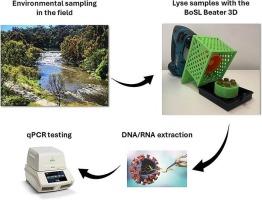A low-cost homogenizing device for in-field and remote DNA and RNA extraction
IF 2
Q3 ENGINEERING, ELECTRICAL & ELECTRONIC
引用次数: 0
Abstract
Environmental monitoring of microorganisms is critical for the protection and enhancement of human and ecosystem health. Even though these molecular methods have overtaken traditional culture-based methods and become more accessible, these techniques still require expensive equipment and dedicated facilities to process samples which in the context of a global pandemic, remote sampling areas or low-income countries can be extremely challenging. Sample preparation and sample homogenisation are critical steps for molecular-based techniques, especially for the extraction of DNA and RNA. This study developed a low-cost, open-source, freely available 3D printed homogenizer for the processing of DNA and RNA extraction. The BoSL Beater 3D is a portable device that allows researcher to perform bead-beating steps commonly required for environmental sample extraction protocols in the field and without access to main’s power. The BoSL Beater 3D was tested on filtered wastewater samples and passive samplers exposed to wastewater over a 24-hour period and showed similar or better performance to the traditional laboratory bead beater for both the extraction of DNA and RNA. The cost of this 3D homogeniser is roughly $18 AUD ($296 AUD with the jigsaw, which is roughly 57 times cheaper than a traditional bead beater) and has the added usability of being portable and easily adaptable to any type of jigsaw. In combination to newly developed field extraction kits as well as portable PCR machines, this 3D homogeniser could provide the tool necessary to enable access to molecular testing in remote setting as well as developing countries, which may not have access to fully equipped laboratories, but also allow for timely reporting. In addition, the BoSL Beater 3D, in combination with field extraction kit, can allow more flexibility to researchers while sampling, shipping, and processing DNA and RNA samples, whilst maintaining quality of these samples.

用于现场和远程 DNA 和 RNA 提取的低成本均质装置
微生物的环境监测对于保护和提高人类及生态系统的健康至关重要。尽管这些分子方法已经超越了传统的培养方法,变得更容易获得,但这些技术仍然需要昂贵的设备和专用设施来处理样本,这在全球大流行病、偏远采样地区或低收入国家的背景下可能极具挑战性。样品制备和样品均质化是分子技术的关键步骤,尤其是 DNA 和 RNA 的提取。本研究开发了一种低成本、开源、免费的 3D 打印匀浆器,用于 DNA 和 RNA 的提取处理。BoSL Beater 3D是一种便携式设备,可让研究人员在没有电源的情况下,在野外执行环境样本提取方案中常见的打珠步骤。BoSL Beater 3D对过滤废水样本和暴露在废水中24小时的被动采样器进行了测试,结果显示,在提取DNA和RNA方面,BoSL Beater 3D的性能与传统的实验室打珠机相似,甚至更好。这种三维匀浆器的成本约为 18 澳元(带拼图的成本为 296 澳元,比传统打珠器便宜约 57 倍),而且还具有便携和易于适应任何类型拼图的特点。结合新开发的现场提取试剂盒和便携式 PCR 机,这种三维匀浆器可提供必要的工具,使偏远地区和发展中国家(可能没有设备齐全的实验室)也能进行分子检测,同时还能及时报告。此外,BoSL Beater 3D与野外提取套件相结合,可以让研究人员在取样、运输和处理DNA与RNA样本时更加灵活,同时保证样本的质量。
本文章由计算机程序翻译,如有差异,请以英文原文为准。
求助全文
约1分钟内获得全文
求助全文
来源期刊

HardwareX
Engineering-Industrial and Manufacturing Engineering
CiteScore
4.10
自引率
18.20%
发文量
124
审稿时长
24 weeks
期刊介绍:
HardwareX is an open access journal established to promote free and open source designing, building and customizing of scientific infrastructure (hardware). HardwareX aims to recognize researchers for the time and effort in developing scientific infrastructure while providing end-users with sufficient information to replicate and validate the advances presented. HardwareX is open to input from all scientific, technological and medical disciplines. Scientific infrastructure will be interpreted in the broadest sense. Including hardware modifications to existing infrastructure, sensors and tools that perform measurements and other functions outside of the traditional lab setting (such as wearables, air/water quality sensors, and low cost alternatives to existing tools), and the creation of wholly new tools for either standard or novel laboratory tasks. Authors are encouraged to submit hardware developments that address all aspects of science, not only the final measurement, for example, enhancements in sample preparation and handling, user safety, and quality control. The use of distributed digital manufacturing strategies (e.g. 3-D printing) is encouraged. All designs must be submitted under an open hardware license.
 求助内容:
求助内容: 应助结果提醒方式:
应助结果提醒方式:


